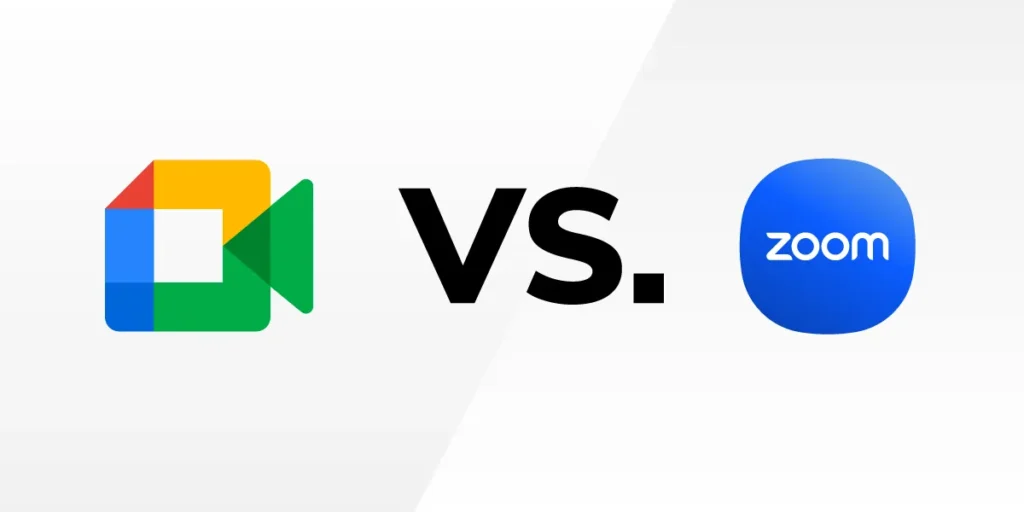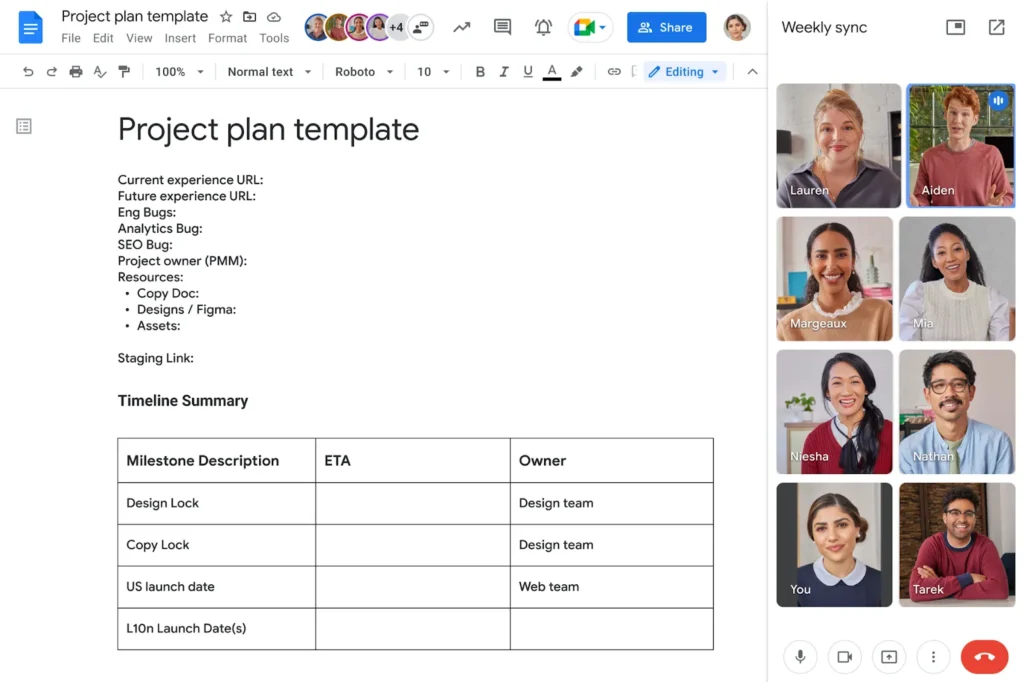Near the beginning of the COVID-19 pandemic, we published a blog pitting Google Meet against Zoom, illustrating why Meet was the better choice.
A lot has changed since then. Organizational digital transformation efforts have been accelerated by years. As cities and states shift in and out of lockdowns, remote-work accommodations that employers (and workers) thought were temporary are turning into long-term, possibly permanent arrangements. Once-obscure terms like “digital nomad” have entered the common vernacular.
Google Meet vs. Zoom at a glance
Google Meet and Zoom are two of the most widely used video conferencing platforms, each offering a range of features for virtual meetings, webinars, and remote collaboration. Seamlessly integrated with Google Workspace, Google Meet provides easy accessibility and scheduling for users familiar with Google’s ecosystem. It offers features such as real-time captioning and integration with Google Calendar. On the other hand, Zoom is known for its ability to accommodate large meetings (with up to 1,000 participants). Google recently enabled meetings that can scale up 1,000, but there are some limitations (which we’ll discuss later in this blog). Your choice between Google Meet and Zoom may depend on your familiarity with their respective ecosystems and the specific features that align with your video conferencing needs.
| Google Meet | Zoom | |
|---|---|---|
| Price | Free plan and paid plans available for individuals and organizations, respectively; paid plans include the Google Workspace suite of productivity & collaboration tools | Free plan and paid plans available for individuals and organizations, respectively |
| Monthly Plans Business Starter: $7.20/user/month Business Standard: $14.40/user/month Business Plus: $21.60/user/month Enterprise: Contact Sales | Monthly Plans Pro: $15.99/user/month Business: $19.99/user/month Business Plus: $25.00/user/month Enterprise: Contact Sales | |
| Annual Plans Plans have a one-year commitment or have a one-time payment Business Starter: $6.00/user/month ($72/user/year) Business Standard: $12.00/user/month ($144/user/year) Business Plus: $18.00/user/month ($216/user/year) Enterprise: Contact Sales | Annual Plans Plans have a one-year commitment or have a one-time payment Pro: $149.90/user/year Business: $199.90/user/year Business Plus: $250.00/user/year Enterprise: Contact Sales | |
| User-friendliness | Anticipates user needs with automatic video and mic check Minimalistic user interface Easy to use No software to install–use any modern browser or mobile device | Defaults to mic being on mute More complex user interface A bit more complex to use Desktop application is more feature-rich than web and mobile apps |
| Allotted group meeting time | Free plan: 1 hour Paid plans: 24 hours | Free plan: 40 mins Paid plans: 30 hours |
| Maximum Participants | Business Starter: 100 Business Standard/Enterprise Essentials: 150 Business Plus/Enterprise Standard: 500 Enterprise Plus/Enterprise Essentials Plus customers can scale their meetings to 1,000 attendees, with 500 attendees being viewers | Pro: 100 Business/Business Plus: 300 Enterprise: 500 |
| Large Meetings | Enterprise Plus/Enterprise Essentials Plus customers can scale their meetings to 1,000 attendees, with 500 attendees being viewers | Enterprise Plus required or you need the Large Meetings add-on starting at $600/year |
| Video and background settings | Customization available both before and during calls | Customization available both before and during calls |
| Chat | Chats of recorded meetings can be saved Features such as Reactions are restricted with Client-side Encryption | Chats of recorded meetings can be saved Account owners and admins can restrict use of certain features such as participants using emojis or keep them on mute Private messages can be sent |
| Breakout rooms | Host selects breakout rooms manually or can assign randomly Time limit for breakout rooms can be set | Host or co-host can allow participants to select their own breakout room Time limit for breakout rooms can be set Messages can be broadcast to all breakout rooms |
| Whiteboard | Whiteboard feature included Advanced whiteboard features available through Miro integration | Whiteboard feature included Advanced whiteboard features available through Miro integration |
| Cloud Storage | Drive Business Starter: 30GB/user Business Standard: 2TB/user Business Plus: 5TB/user Enterprise: 5TB+/user (more available on request) | Zoom Cloud Pro: 5GB/user Business: 5GB/user Business Plus: 10GB/user Enterprise: “Unlimited” |
| Screen sharing | Screen sharing available Second camera can be shared Whiteboard can be shared | Screen sharing available Second camera can be shared Whiteboard can be shared 1080p resolution is available for screen sharing |
| Recording | Recordings saved to Google Drive | Recordings saved to local or Zoom Cloud storage |
| Closed captioning | Closed captioning and live transcription available | Closed captioning and live transcription available, but live transcription is not supported on ChromeOS |
| Security | Encryption Two-factor authentication Group policy controls Premium features available for higher tier clients | Encryption Two-factor authentication Group policy controls |
| Integrations | Zapier integration is available Full integration with Google Workspace products | Zapier integration is available |
| Mobile experience | Mobile app has intuitive UI Polls and Q&A can be launched Participants can collaborate on a Jamboard | Mobile app has intuitive UI Cannot launch polls & Q&A Whiteboards can be viewed |

Google Meet and Zoom similarities
While Google Meet and Zoom offer distinct features and functionalities, there are several aspects where they share similarities:
- Video conferencing basics: Both platforms provide the fundamental features of video conferencing, including video and audio communication, screen sharing, chat functionality, and the ability to join meetings via web browsers or dedicated apps.
- Meeting recording: Google Meet and Zoom allow users to record meetings, capturing audio, video, and screen-sharing content. Recorded meetings can help review discussions, share with absent participants, or be used for archiving purposes.
- Mobile apps: Google Meet and Zoom offer mobile apps for iOS and Android devices, allowing users to participate in meetings while on the go. These apps provide a streamlined experience for joining meetings, viewing shared content, and engaging in discussions.
- Integration with calendar platforms: Google Meet integrates seamlessly with Google Calendar, while Zoom integrates with various calendar applications. This integration allows users to schedule meetings and send invitations directly from their preferred calendar app.
- Participant management: Both platforms offer features for managing meeting participants, such as muting and unmuting attendees, enabling or disabling video, and controlling screen-sharing permissions.
- Screen sharing: Google Meet and Zoom allow participants to share their screens with others during meetings. This feature is handy for presentations, demonstrations, and collaborative work sessions.
- Virtual backgrounds: Both platforms offer the ability to use virtual backgrounds, allowing users to replace their physical surroundings with a digital backdrop. This feature helps maintain privacy and enhance the visual appeal of meetings.
While there are many similarities between Google Meet and Zoom, it’s important to note that they also have unique features and capabilities that may influence your choice. Factors such as pricing, integration with other tools, and specific feature requirements will ultimately determine which platform better suits your needs.
Google Meet is considered by many to be more user-friendly than Zoom, but Zoom has a larger participant capacity
Google Meet and Zoom cater to different user experiences, with Google Meet leaning towards user-friendliness and simplicity while Zoom is attractive to organizations that need a large meeting capacity. Zoom scales up to 1,000 participants. And while Google Workspace Enterprise Plus, Enterprise Essentials Plus, and Education Plus customers can scale their meetings to 1,000 attendees, 500 attendees are designated as viewers only (meeting attendees who cannot share their audio or video into the meeting).
Google Meet’s interface is streamlined and intuitive, making it easy for users to initiate or join meetings without much hassle. The integration with Google Calendar and the overall familiarity of Google’s ecosystem contribute to its user-friendly nature.

Ultimately, the choice between Google Meet and Zoom depends on your priorities. If user-friendliness and straightforward communication are your primary concerns, Google Meet is a strong contender. In addition, if your organization wants to boost productivity with features that allow teams to seamlessly jump on a video call from Chat or take document collaboration to the next level by connecting over video, Google Meet’s integration with Google Workspace is a major benefit. However, if your organization is often in scenarios that require large meeting capacity, Zoom might be the better choice (though, with Google Meet, live streaming is available with certain Google Workspace Editions if you need to host a larger meeting.
Google Meet and Zoom have solid chat features, but Google Meet’s integration with Google Workspace takes collaboration to the next level
While Google Meet and Zoom both offer chat features that facilitate communication during virtual meetings, Zoom’s chat feature could be elevated with more seamless integration and better organization. Zoom’s lack of integration with other collaboration tools, like note-taking apps or project management software, make it more difficult for users to switch between communication and action seamlessly. Google Meet, on the other hand, offers deep integration with Google Workspace, making it easy to work seamlessly with tools like Docs, Sheets, and Slides.

5 Reasons Why Google Meet is Superior than Zoom
In a world where everything has changed, it’s nice to know that at least one thing remains the same. Google Meet is still the superior alternative to Zoom, and here are 5 reasons why.
1. Google Meet doesn’t require any additional software on desktops
While Zoom requires desktop users to download a desktop app or browser plugin for full functionality, Google Meet allows meeting hosts and attendees to manage and join meetings from the web browser of their choice simply by visiting meet.google.com, with no additional software required.
In addition to being more convenient, Meet’s browser-based platform minimizes organizations’ potential attack surface and eliminates the need for IT administrators to keep a desktop app or browser plugin updated. It also ensures that users won’t download a phony desktop installer that’s bundled with malware, which was a problem for Zoom in 2020.

2. Google Meet is secure by default
During the pandemic, Zoom recieved a lot of backlash for Zoombombing, a practice where malicious, often uninvited users hijack Zoom meetings to share offensive or disruptive content. In response, Zoom has implemented various security updates and features to address these issues, such as password protection, waiting rooms, and encryption enhancements. These measures require meeting hosts to do more work when setting up meetings, but one study reveals that these measures do little to deter Zoombombers, who are usually invited participants, not external cybercriminals.
Google Meet, on the other hand, benefits from the Google Cloud Platform (GCP) defense-in-depth approach to security, which utilizes Google’s built-in protections and global-private network. Initially developed as part of Google’s suite of business and productivity tools, known as G Suite (now rebranded as Google Workspace), it was designed with a focus on security, privacy, and enterprise-grade features to meet the needs of businesses and organizations. Google Meet was built on the foundation of Google’s expertise in managing large-scale infrastructure and security protocols. Google Meet hosts don’t have to take additional steps to prevent their meetings from being hijacked by disruptive attendees. Easily accessible security controls enable Google Meet organizers to mute or remove disruptive participants, and meeting attendees can report abusive behavior in meetings. Anonymous attendees can’t join Meet conferences; all attendees must have a Google account. This enables hosts to identify disruptive participants and avoid situations like the one that unfolded in Juneau, Alaska, where a city assembly member was harassed by an anonymous participant in a Zoom meeting.
3. Meet offers the same experience on mobile as on desktop
Zoom users on mobile face a severely downgraded user experience compared to the desktop app. Most notably, Zoom’s mobile apps lack the full range of host controls available on the desktop, such as the ability to launch a poll, start breakout rooms, or stream meetings publicly.
In contrast, Google Meet offers the same functionality and user experience on mobile as it does on the desktop. With Meet’s specially designed iOS and Android apps, users can view all of their meetings for the day Calendar, then join by tapping or dialing in.

4. Google Meet offers superior encryption
Zoom reached a settlement with the U.S. Federal Trade Commission (FTC) over allegations that the company had misled its customers into thinking their meetings were secured by end-to-end encryption when they weren’t. As we discussed in our previous blog, Canadian security researchers had discovered that Zoom’s encryption algorithm had some very serious and well-known weaknesses.
Google Meet has always encrypted all data in transit by default, adhering to IETF security standards for Datagram Transport Layer Security (DTLS) and Secure Real-time Transport Protocol (SRTP). Meet generates a unique encryption key for every person and every meeting. This key is transmitted in an encrypted and secured RPC (remote procedure call) during the meeting setup, lives only as long as the meeting, and is never stored to disk.

5. Google is committed to protecting your privacy
The same Canadian researchers who uncovered the issues with Zoom’s encryption algorithm also discovered that Zoom sometimes uses encryption keys issued by servers in China, even when the meeting host and all participants are located in North America. Hypothetically, the researchers noted, if the Chinese government were to demand that Zoom hand over the encryption keys to a particular meeting, Zoom would be legally obligated to do so.
These warnings came to fruition when the U.S. Department of Justice (DOJ) issued an arrest warrant for Jin Xinjiang, aka Julien Jin, a former Zoom executive who had worked as a liaison between Zoom and the Chinese government. The DOJ is accusing Jin of working with intelligence services in Beijing to interfere in Zoom calls, organized and hosted by U.S-based individuals, that were being held to commemorate the June 4, 1989, Tiananmen Square massacre.
In contrast, Google is committed to customer data privacy. Google Meet data, like all other data stored on Google Cloud, is processed only according to customers’ instructions, and it is never used for advertising purposes. Google never accesses customer data unless doing so is absolutely necessary to fulfill its contractual obligations, such as when resolving a technical or security issue. Google will never give any government entity “backdoor” access to your data or to our servers storing your data.
Google Workplace Enterprise and Google Workplace for Education customers are also covered by Google Cloud’s Access Transparency policy, a feature that is unique to Google Cloud. Google’s Access Transparency controls require employees to provide a valid business justification to access Google Meet recordings stored in Drive. The employee must fill out a log noting the date, time, and reason for the access, and Google performs regular audits to ensure that these controls are being adhered to.
Customers can also use Google’s Data Regions feature to choose the geographic location where select/covered data for Google Meet recordings will be stored at rest.
This blog is an independent production of SADA Systems Inc., an award-winning reseller of Google Cloud products and services. SADA is an independent third party and has no affiliation with either Google LLC or Zoom Video Communications, Inc. Neither Google Cloud nor Zoom were involved in the drafting or production of this blog. All errors or omissions are SADA’s sole responsibility.
FAQ
Both Google Meet and Zoom have taken steps to improve their security. Google Meet has end-to-end encryption for meetings, and Google is known for its security measures. Zoom faced security issues but also implemented fixes. Both can be safe if used with proper settings, but Google Meet’s encryption might give it a slight edge in terms of security. Always check the latest security updates before making a decision.
Google Meet has both free and paid plans available for users. The free plan allows users to conduct video meetings with a limited set of features and duration. Paid plans, on the other hand, offer additional features such as longer meeting durations, larger participant limits, and advanced administrative controls. These paid plans are often part of Google Workspace (formerly G Suite), which is a suite of productivity and collaboration tools for businesses and organizations. The availability of features and limitations can vary based on whether you’re using the free version or a paid plan.
Google Meet’s free version has a 60-minute time limit on group calls (3 or more participants) while one-on-one calls can last up to 24 hours.
Google Meet is highly regarded due to its strong security, integration with Google tools, accessibility, user-friendly interface, large participant capacity, live captioning, and recording features. It offers both free and paid plans, making it a versatile option for various needs.




